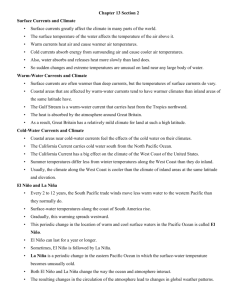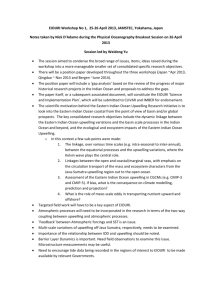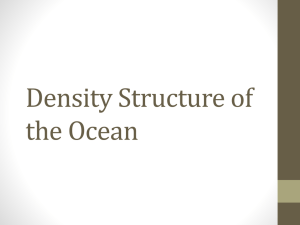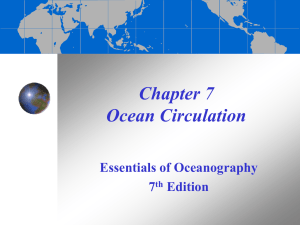Lecture 14b: Ocean Circulation
advertisement
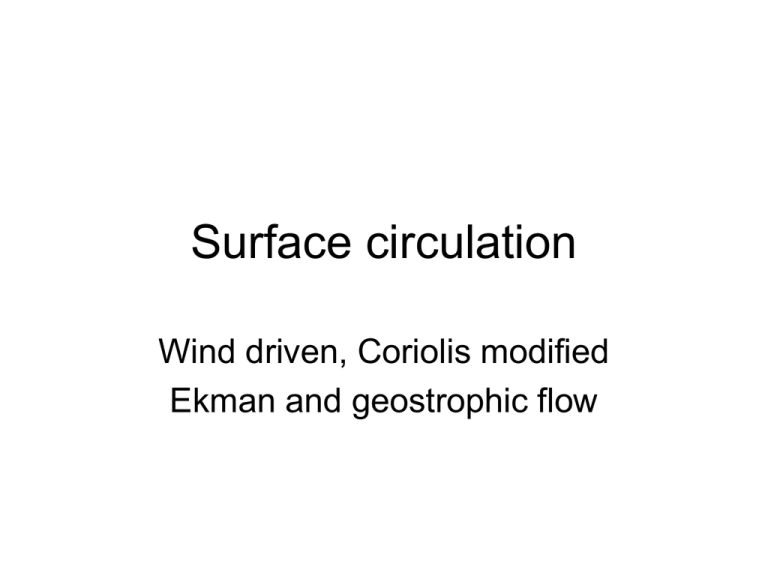
Surface circulation Wind driven, Coriolis modified Ekman and geostrophic flow Surface currents - patterns • Similar in all basins • At low latitudes, have large, “closed” gyres – Gyres elongated in the E-W direction – Gyres centered on the subtropics (~30oN or S) • West-directed flow at N and S equatorial currents • East-directed flow ~ 45oN and S • N-S directed flow at eastern and western boundary currents Surface currents - patterns • West-directed flow driven by tradewinds (coming from N or S-east • East-moving equatorial countercurrents • Western boundary currents are distinct, narrow (< 100km), swift (>100 km/day) and deep (2 km) • Eastern boundary currents are broad (>1000 km), weak (~10s km/day) and shallow (~500 m) • Have smaller, less developed polar gyres in N • Have circumpolar “gyre” in the S Transverse currents • E-W currents driven by the trade winds (easterlies) and mid-latitude westerlies • Link the boundary currents • Equatorial currents – Moderately shallow and broad – Pile up water on west side of basin (W Atl is 12 cm [8”] higher than Pac; W Pac is 1 m higher than E Pac) • Eastward flowing currents at mid-latitudes are weaker (wider and slower) than equatorial currents • Differences in land mass distribution in N and S hemispheres affects flow Change in productivity rates affects atm CO2? Assume these fluxes are balanced Change in burial rates affects atm CO2? Fig. 8-9 Why is this important? Processes in surface, wind-driven layers are different but connected to processes in deep waters. Short-term Long term (organic) Long term (inorganic/tectonic) Link with short term C cycle In surface oceans Onset of modern plate tectonics “turns this on” “adds” back CO2 Thermohaline Circulation Thermohaline circulation • Vertical water movement • Driven by density differences (can be very small) – Remember temperature and salinity diagrams and the properties of water – Temperature and salinity profiles (with depth) – Salty water is denser than fresh water – Cold water is denser than warm water • Density gradients with latitude (due to temperature differences of surface waters) – Polar water has the most uniform density (weakest pycnocline) so is least stable Fig. 5-6 •Polar water column is least stable; most uniform density weakest pycnocline •Surface is cold •Deep water is cold everywhere •Easiest to rearrange •Formation of ice excludes salt •Seawater freezes at –2oC Warming Cycle: 1. March 2. May 3. June 4. August Cooling Cycle: 1. August 2. September 3. October 4. November 5. January Temp. sea water Wind Most of the ocean is cold Temperature degree C Thermohaline circulation • As for the atmosphere, there are convergence and divergence zones where water masses collide or diverge • Important for global heat balance • Deep circulation and basin exchange of water, material, and heat Thermohaline circulation • • • • Deep circulation is driven by density differences Horizontal movement along density surfaces Movement is very slow (0.1 m/s) Three layer ocean – surface mixed layer – Pycnocline – Deep water • Deep water formed at 2 places – N Atlantic and Weddell Sea (Antarctica) • Connection between surface and deep water – Diffusion (slow and along density gradients) – Mixing (e.g., storms) – Upwelling (polar, equatorial and coastal) Deep circulation is like a conveyer belt that moves heat and water Water masses • Possess identifiable properties • Don’t mix easily – flow above or beneath each other – – – – – Surface water – to about 200 m Central water – to bottom of main thermocline Intermediate water – to about 1500 m Deep water – to about 4000 m (not the bottom) Bottom water – in contact with seafloor • Retain characteristics when the mass was formed at the surface (heating/cooling, evaporation/dilution) Formation of deep water • Antarctic bottom water – densest water in the ocean – S (34.65%o), T (-0.5oC), dens (1.0279) – Weddell Sea in winter – when ice freezes and get brines – Sinks and creeps North – Pacific and Atlantic – 100’s to 1000’s of years to get to northern basin • North Atlantic deep water – Formed in the Arctic but escapes only through channels – Warm, salty water chills (heat is transferred to air) • Atlantic and Pacific deep water is less dense than Antarctic bottom water Mediterranean deep water • Salty water (38 %o) • Underlies central water mass in Atlantic • Warmer than other deep water so not as dense Increasing density • Different combinations of temp and salinity can make water of the same density • Isopycnal is a line of constant density • Mixing of water masses can increase the density Age of a water mass • Oxygen and C isotopes • Water picks up oxygen and CO2 only at surface by exchange with atmosphere • Loses oxygen as it ages (respiration, reaction with rocks); 14C decays as it ages • Water masses mix slowly • Antarctic bottom water in the Pacific retains its character for up to 1600 years Fig. 8-11 -70‰ ∆14C -230‰ -110‰ -210‰ -150‰ -170‰ -150‰ -170‰ This diagram represents the flow at a depth of 4000 m; the strange-looking continent/ocean configuration is what we would obtain if the oceans were drained to this depth. (After W.S. Broecker and T.-S. Peng, Tracers in the Sea, New York: Eldigio Press, 1982, Figure 1-12.) Water residence time • Bottom currents are slow • Antarctic bottom water ~1600 years • Other bottom water – 200-300 years (time it takes to rise to the surface) • Fast bottom currents on bottom around objects • Surface currents are faster • Surface water – on the order of years – N Atlantic gyre may take about 1 year to complete a circuit Deep water circulation • Flow may be slow but still modified by Coriolis Convergence zones • Two water masses meet • Usually one will go under the other (density) • If the same density, may mix to create a new and denser water mass (remember TS diagram) – this is caballing • Formation of N Atlantic intermediate water, Antarctic intermediate water and Antarctic bottom water produced by mixing •S-curve tracks density with depth •Points a and b on an Isopycnal so are the same density, despite different temperatures and salinities •If the two water masses mix, will result in denser water! Convergence zones • Areas of downwelling • Antarctic convergence zone at 50-60oS – South of this is the Antarctic Circumpolar Current • Subtropical convergence zone (40-50oS) – N boundary of Subantarctic Surface Water • Equatorward of subtropical convergence zone is Central Water which is the warmest and saltiest water • Subtropical convergence (45-60oN) • Arctic convergence – ill-defined because of land mass in the N Divergence zones • Areas of upwelling • Tropical divergence • Antarctic divergence Upwelling • Sinking water must be offset by upwelling of water • Water sinks in a localized area, relatively rapidly • Water rises gradually over larger areas • When water moves to surface, must be transported to a pole to sink again • Diffuse upwelling maintains a permanent thermocline (1 cm/d) Maintained by diffuse upwelling Main thermocline Thermohaline flow • Sinking of surface water most pronounced in the North Atlantic • Water moves at great depths toward Southern hemisphere and wells up into the surface in the Indian and Pacific Oceans (~1000 years) • Slow circulation that crosses hemispheres superimposed on rapid flow of surface water in gyres • Some heat travels from S Pacific, across Indian Ocean and into the Atlantic • Flow distributes gases, solids, nutrients and organisms among ocean basins Fig. 5-12 Fig. 8-9 The Redfield Equation 106 CO2 + 16 NO3- + HPO42- + 122 H2O (CH2O)106(NH3)16(H3PO4) + 138 O2 Can also develop similar ratios for trace elements required for growth (e.g., Fe, Mn, Zn, etc.) Box Fig. 8-1 Shallow upper mixed layer and main thermocline Uptake by phytoplankton Short residence times Regeneration during particle sinking Ocean circulation and/or vertical mixing Long residence times Thermohaline circulation Norwegian Sea POM POM POM Atlantic Indian POM Pacific Nutrient regeneration and O2 consumption O2 decreases, nutrients increase as deep water is transported/ages undersat’d. supersat’d. plus nutrients fixed into the organic matter and pCO2 Coastal Upwelling Major upwelling zones Wind-induced upwelling Note that transport goes to the right in the N Hemisphere Seasonal upwelling due to seasonally reversing monsoonal winds Seasonal upwelling Summer Wind direction resulting from differential pressure over sea and land superimposed on a SeaWiFS chlorophyll image for the southwest monsoon. High chlorophyll concentrations in the western Arabian Sea are due to coastal upwelling (see animation at http://www.bigelow.org/climatechange/Animation.htm) Winter Schematic showing snow cover extent and wind direction superimposed on a SeaWiFS chlorophyll image for the northwest monsoon season. High chlorophyll concentrations are due to nutrients inputs from of winter convective mixing Equatorial upwelling Equator SE trades CO2 from the atmosphere O2 to the atmosphere Brings nutrients back for production (100 %) (> 99%) (< 1%) Fig. 8-9 Net burial of CH2O in sediments The Oceanic P Cycle (all fluxes are 1010 mole P/yr) River input Surface Ocean [PO4]avg = 0.15 µM Downwelling For example phosphorus in the whole ocean 35 Particle flux 7.5 215 187.5 Upwelling Whole Ocean [PO4]avg = 2.05 µM Ocean P concentration (1.4 1021 l)(2.05106 M) whoc 351010 m olP / yr 8,200yr Input = output Deep Ocean [PO4]avg = 2.2 µM Ocean volume Burial in sediments 35 The Oceanic P Cycle (all fluxes are 1010 mole P/yr) Very different in its component parts River input Surface Ocean [PO4]avg = 0.15 µM Downwelling 35 Particle flux sfc 187.5 (11020 l)(0.15 106 M) 222.5 1010 m olP / yr 6.7yr 7.5 Deep Ocean [PO4]avg = 2.2 µM Whole Ocean [PO4]avg = 2.05 µM 215 Upwelling Burial in sediments 35 (1.3 1021 l)(2.2 106 M) deep 222.5 1010 m olP / yr 1,285yr (1.4 1021 l)(2.05106 M) whoc 351010 m olP / yr 8,200yr Meanders and eddies • Currents are water so, lack well-defined edges so have friction with adjacent boundaries • Meanders as it flows poleward • Sometimes get rings (warm and cold core) pinched off • Warm-core eddies rotate CW (in the N hemisphere) • Cold-core eddies rotate CCW (in the N hemisphere) • Can be 1000 km in diameter and persist for years, effects may be felt to the bottom and may be important for mixing up deep water (& nutrients) Colder productive water Warm, clear water Eddies • Meanders pinch off • Trap warm or cold water at their center • Cold-core eddies in the Gulf Stream • Warm-core eddies N of the Gulf Stream • Cold-core eddies very nutrient rich and productive • Warm-core ring • Cold-core ring Kuroshio eddies in natural color! Green is phytoplankton Formation of Rings • Retain momentum of current • Warm-core rings spin CW (N hemisphere) • Cold-core rings spin CCW (N hemisphere Rings can penetrate to great depth To the seafloor? Cold ring has low pressure “upwelling” in the center (Coriolis deflection to the right in N hemisphere) while warm ring has high pressure downwelling in the center (same reason). El Niño/La Niña • Normally get surface winds across the tropical Pacific moving East to West (easterlies or trade winds) • High pressure over eastern Pacific and Low pressure over western Pacific maintains this pattern • But, these pressure systems reverse or collapse with some periodicity (every 3-8 years) • Winds reverse and trade winds weaken or collapse • Change in atmospheric pressure is Southern Oscillation • Serious effects on productivity El Niño/La Niña • Wind-driven equatorial currents weaken or collapse • Warm water “sloshes” or flows eastward • Get east-flowing warm water around Christmas-time and this is El Niño • Combine terms and get El Niño Southern Oscillation (ENSO) El Niño • El Niños occurred in the E Pac during 1986-87, 1991-92, 1993, 1994 and 19971998, 2002-2003. 2006-2007 • Vary in strength Normal air pressure Normal SST with Upwelling Storms over land increase (CA) Deeper thermocline Failed upwelling or downwelling El Niño SST with warm current and little or no upwelling http://www.pmel.noaa.gov/tao/elnino/la-nina-story.html Normal Warm pool Effects on productivity ENSO events • Thermocline deepens in the Eastern Pacific (EP) • Productivity decreases in EP • Sea level rises in EP • Increases rain and storms on adjacent land – Milder temps on west coast? – This year’s CA storms? La Niña • Not always right after an El Niño even • Colder-than-normal event • Thermocline decreases from normal (more intense upwelling) • Resumption and strengthening of trade winds • Winter temps warmer in SE and cooler in NW • Effects opposite of El Niño North Atlantic Oscillation • Seesaw of atmospheric mass between subtropical high and polar low • Dominant mode of winter climate variability in the North Atlantic • Positive NAO index is stronger than usual subtropical high and deeper than normal Icelandic Low – stronger than average westerlies at mid-latitudes • Increased pressure difference results in – Stronger winter storms crossing Atlantic – More northerly track to storms • Warm and wet European winter and cold and dry N Canada and Greenland winter • Mild and wet winter in Eastern USA

